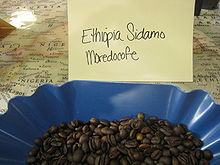- Coffee production in Ethiopia
-
The coffee production in Ethiopia is critical to the Ethiopian economy with about 25% of the population depending directly or indirectly on coffee for its livelihood.[1] In 2006 coffee exports accounted some $350 million,[2] equivalent to 34% of that year's total exports.[3]
Contents
History
According to legend, the 9th-century goatherder Kaldi discovered the coffee plant in Ethiopia after noticing the energizing effect the plant had on his flock, but the story did not appear in writing until 1671 and is probably apocryphal.[4]
Production
Ethiopia is the world's 7th largest producer of coffee, and Africa's top producer, with 260,000 metric tonnes in 2006.[5] Half of the coffee is consumed by Ethiopians,[1] and the country leads the continent in domestic consumption.[6] The major markets for Ethiopian coffee are the EU (about half of exports), East Asia (about a quarter) and North America.[7] The total area used for coffee cultivation is estimated to be about 4,000 km2 (1,500 sq mi), the size is unknown due to the fragmented nature of the coffee farms.[8] The way of production has not changed much since the 10th century, with nearly all work, cultivating and drying, still done by hand.[1]
The revenues from coffee exports account for 10% of the annual government revenue, because of the large share the industry is given very high priority, but there are conscious efforts by the government to reduce the coffee industry's share of the GDP by increasing the manufacturing sector.[9]
The Coffee and Tea Authority, part of the federal government, handles anything related to coffee and tea,[8] such as fixing the price at which the washing stations buy coffee from the farmers. This is a legacy from a nationalization scheme set in action by the previous regime that turned over all the washing stations to farmers cooperatives.[10] The domestic market is heavily regulated through licenses, with the goal of avoiding market concentration.[10]
Regional varieties
Ethiopian coffee beans that are grown in either the Harar, Sidamo, Yirgacheffe, or Limu regions are kept apart and marketed under their regional name.[11][6] These regional varieties are trademarked names with the rights owned by Ethiopia.[12]
Sidamo
"Ethiopia Sidamo" is a type of Arabica coffee of single origin grown exclusively in the Sidamo Province of Ethiopia. Like most African coffees, Ethiopia Sidamo features a small and greyish bean, yet is valued for its deep, spice and wine or chocolate-like taste and floral aroma. The most distinctive flavour notes found in all Sidamo coffees are lemon and citrus, with bright crisp acidity. Sidamo coffee includes Yirgachefe Coffee and Guji Coffee. Both coffee types are very high quality.
Harar
"Ethiopian Harar" is a coffee bean of the species arabica that is grown in the region of Harar in the Eastern highlands of Ethiopia. It is one of the oldest coffee beans still produced and is known for its distinctive fruity, wine flavour. The bean is medium in size, with a greenish-yellowish colour. It has medium acidity and full body and a distinctive mocha flavour. Harar is a dry processed coffee bean,[13] with sorting and processing done almost entirely by hand. Though processing is done by hand, the laborers are extremely knowledgeable of how each bean is categorized.[13] Harar beans can be divided into three categories: Longberry, Shortberry, and Mocha. Longberry varieties consist of the largest beans and are often considered of the highest quality, in both value and flavor. In some cases this is true but more often than not it's just a marketing pitch. Shortberry varieties are smaller than the Longberry beans but, are considered a high grade bean in Eastern Ethiopia where it originates. Also the Mocha variety is a highly prized commodity. Mocha Harar's are known for their peaberry beans. Peaberries are coffee beans with one bean per coffee cherry, unlike the common coffee cherry which holds two beans. Even though this is a formality defect, it is one of the highest valued coffees in the world. It is known for having very distinct aromas and flavors of chocolate, spices, and a complex of citrus notes.
See also
- Agriculture in Ethiopia
- Coffee ceremony
- Ethiopian coffee dress
- Oromia Coffee Farmers Cooperative Union
References
- ^ a b c Cousin, Tracey L (June 1997). "Ethiopia Coffee and Trade". American University. http://www.american.edu/TED/ethcoff.htm. Retrieved May 10, 2010.
- ^ "CIA World Factbook". Central Intelligence Agency. http://www.allcountries.org/wfb2007/ethiopia/ethiopia_economy.html. Retrieved 20 July 2010.
- ^ "CIA World Factbook". Central Intelligence Agency. https://www.cia.gov/library/publications/the-world-factbook/geos/et.html. Retrieved 20 July 2010.
- ^ Weinberg & Bealer 2001, pp. 3–4
- ^ "Food and Agricultural commodities production". Food and Agriculture Organization. http://faostat.fao.org/site/339/default.aspx. Retrieved 14 July 2010.
- ^ a b "Major coffee producers". National Geographic Society. http://www.nationalgeographic.com/coffee/map.html. Retrieved 2010-05-07.
- ^ Keyzer, Merbis & Overbosch 2000, p. 33
- ^ a b Belda 2006, p. 77
- ^ Belda 2006, p. 79
- ^ a b Keyzer, Merbis & Overbosch 2000, p. 35
- ^ "The coffee paradox: global markets ... - Google Books". books.google.co.uk. http://books.google.co.uk/books?id=mwpAO0J9ojgC&pg=PA99&dq=ethiopian+limu+coffee&hl=en&ei=TNZPTf-3IIebhQfAhLHDDg&sa=X&oi=book_result&ct=result&resnum=5&ved=0CFsQ6AEwBA#v=onepage&q=ethiopian%20limu%20coffee&f=false. Retrieved 2011-02-07.
- ^ "Starbucks in Ethiopia coffee vow". BBC. June 21, 2007. http://news.bbc.co.uk/2/hi/business/6225514.stm. Retrieved 2007-06-21. "Starbucks has agreed a wide-ranging accord with Ethiopia to support and promote its coffee, ending a long-running dispute over the issue."
- ^ a b "About coffee". [dead link] Mountain City Coffee Roasters, Inc.. http://www.mountaincity.com/about_coffee.htm. Retrieved 2009-05-06.[dead link]
- Bibliography
- Belda, Pascal (2006), Ethiopia, MTH Multimedia S.L., ISBN 9788460796671, http://books.google.com/books?id=7X6YOGVaJ7QC.
- Keyzer, Michiel; Merbis, Max; Overbosch, Geert (2000), WTO, agriculture, and developing countries: the case of Ethiopia, Food & Agriculture Org., ISBN 9789251044230, http://books.google.com/books?id=g5ezuomqfCUC.
- Weinberg, Bennett Alan; Bealer, Bonnie K (2001). The world of caffeine : the science and culture of the world's most popular drug. New York: Routledge. ISBN 0415927226. http://books.google.com/?id=Qyz5CnOaH9oC.
 Economy of Ethiopia
Economy of EthiopiaCurrency: Ethiopian birr Communications Industries: Categories:- Economy of Ethiopia
- Coffee production by country
- Agriculture in Ethiopia
- Ethiopian cuisine
Wikimedia Foundation. 2010.


